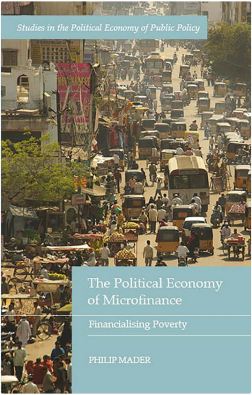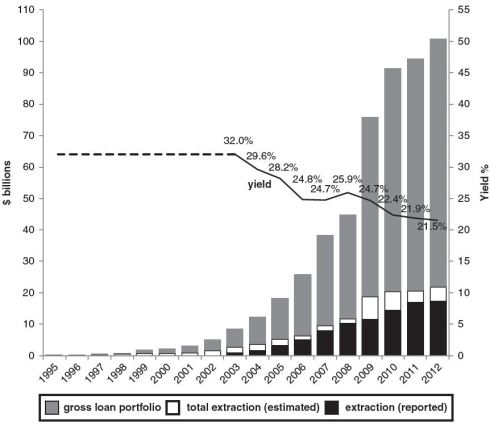You are currently browsing the tag archive for the ‘The Political Economy of Microfinance Financializing Poverty’ tag.
The Nobel Peace Prize awarded to Muhammad Yunus and the Grameen Bank in 2006 went practically unquestioned. But since then, particularly over the last years, a public pro-microfinance/anti-microfinance debate has taken a clear shape with well-known lines of argument running both-ways. Many studies have asked: “Does microfinance work?”. And some have more pointedly asked: “Why doesn’t microfinance work?“.
New questions are needed if new answers are to be generated. The Political Economy of Microfinance: Financializing Poverty offers both. Starting from the question “What does microfinance work at – and how?”, it offers new insights into which have particular significance in light of the continually unresolved issues around poverty impact. More than 35 years into the microfinance experiment, the fact is we still don’t know whether microfinance works at reducing poverty – and there are serious reasons to doubt that it does. What we do know (or can know), however, the book argues, is that microfinance works at financialising poverty.
Excerpt from “The Political Economy of Microfinance: Financializing Poverty”, Chapter 2, A Genealogy of Microfinance. (see other excerpts here)
Microcredit allowed the well-institutionalized tool of credit programming to remain inside mainstream development policy, despite a diminished role for governments, and despite the fall from grace of subsidies. In reality, microcredit programming merely shifted the subsidies and state involvement one level “up”: no longer were loans to the poor subsidized and publicly supported; now the organizations which lent to the poor were subsidized and supported.
Sources: World Bank (2001); Maes/Reed (2012); MIX (2013) = Basic MIX MFI Data Set, as of 26 December 2013.
Reliable data on microfinance from before 2000 are very rare. In the mid-1990s the World Bank surveyed the sector and counted over 900 “institutions which offer microfinancial services” (around 735 of them being “proper” microfinance institutions), each serving at least 1,000 clients. The list included seven large banks and one NGO. The survey tallied around $5 billion in outstanding loans. However, the vast majority of MFIs were recently founded NGOs which placed little, if any, emphasis on savings and received over two-thirds of their funding from donors (see Figure below). This group was fast-growing. The World Bank (2001: 4) noted: “Much of the impetus for this growth comes from donor organizations and NGOs embracing microfinance as the latest tool in development and poverty reduction. Due to the increasing availability of donor funds, microfinance institutions have grown rapidly.”
Standardizing microfinance, financially
The World Bank’s decision to support microfinance primarily through its International Finance Corporation (IFC) arm, whose purpose is “financing private sector investment, mobilizing capital in the international financial markets, and providing advisory services” (IFC 2011), affected which type of organizational model would become dominant: MFIs that were willing and able to manage funds that were channelled from mainstream financial markets were favoured. Read the rest of this entry »
Excerpt from “The Political Economy of Microfinance: Financializing Poverty”, Chapter 2, A Genealogy of Microfinance.
Two basic types of story are commonly told about the origins of modern microfinance. One is the underhistoricized version, whereby Dr Muhammad Yunus (and/or a handful of other pioneers) “invented” or “discovered” it: “The modern microfinance movement began in Bangladesh in 1977, as an experiment by economics professor Muhammad Yunus … Over the next three decades, the model he established became widely accepted and replicated in other countries as a way to fight poverty. Microfinance spread around the world and earned Yunus a Nobel Prize in 2006” (Wharton Business School 2011). In this and similar tales, before the 1970s, microfinance has no meaningful history.
The overhistoricized version meanwhile draws parallels and connections with various prior credit systems and financial interventions, portraying microfinance as part of a long lineage of poverty-alleviation programmes through credit. For instance, “modern microfinance did not arise de novo thirty-five years ago. The ideas within it are ancient, and their modern embodiments descend directly from older successes” (Roodman 2012a: 38). Here, today’s microfinance sector is all history, and merely the temporary pinnacle of a long, quasinatural evolution.
Both stories are unsatisfactory, not least because they downplay (or ignore) the political-economic context of microfinance; they overlook the “visible hand” of the state in its emergence; they fail to show how microfinance arose out of particular historical circumstances (neither as sudden discovery nor as revival of ancient ideas); above all they are blind to the insecurities, uncertainties and contingencies which shaped today’s microfinance sector. Microfinance was neither a sudden and miraculous discovery nor a historical necessity.
Excerpt from “The Political Economy of Microfinance: Financializing Poverty”, Introduction, A Framework for Engaging Microfinance.
Concepts and Euphemisms
There is often confusion about some terms that are commonly used in discussions about microfinance. Before the substantial chapters begin, an explanation of terminological choices which affect the analysis [in this book] is essential.
Microfinance vs. microcredit – There is no consensus definition of microfinance. We may stick to a condensed version of CGAP’s definition [1], following which microfinance is “financial services for poor and low-income people, offered by different types of service providers, most of which designate themselves as microfinance institutions”.
Yet some readers might be irritated by the usage of the term “microfinance” in a book which pays relatively little attention to services such as microsavings or microinsurance. Though I differentiate clearly between microfinance and microcredit in a historical frame – where “microcredit” was the dominant term during an earlier period, while thereafter “microfinance” fell into favour – the term “microfinance” is used otherwise throughout this book to refer to the entire system, even where my analysis focuses on the credit dimension.
Why? First, even though “microfinance” is a relatively recent term – Seibel (2005) claims to have coined it in 1990 – hardly anyone now speaks of “microcredit”, let alone “microenterprise finance”, which was used mainly in the 1990s. The fact that “microfinance” is the dominant term may already be reason enough to use it. But, second, (a) microinsurance and (b) microsavings are more hype than reality. They are practically nowhere standalone businesses, while microcredit often is. Credit was, and remains, the essential element of microfinance, as the most profitable and prominent element.
Excerpt from “The Political Economy of Microfinance: Financializing Poverty”, Chapter 3, The Financialization of Poverty.
Reinforcement for the microfinance narratives of empowerment through finance, and of poverty being a problem of finance [see the last posted excerpt], comes from a vision of poor people as being inherently (or even exceptionally) financially minded subjects. Portfolios of the Poor, written by a team of practitioners and academics who tracked borrowers’ financial lives via financial diaries, has emerged as the key text of the ascendant “financial inclusion” paradigm. Engagingly written but not addressed to very broad audiences, it chiefly provides legitimation among development practitioners, bankers and microfinance experts for their visions of helping poor people to master their lives via financial services. The poor are depicted as Third-World “portfolio managers” (Collins et al. 2009: 238), as savvy and skilful as their Wall Street counterparts, and equally in need of finance. Portfolios effectively portrays the denizens of megacity slums and remote villages, to follow John Steinbeck, as “temporarily embarrassed millionaires” who have merely lost their bank accounts.¹
Underlying the claims made by Portfolios’ authors is the assumption that low-income individuals in the global South are guided by the cognitive framework of the purest specimen of Homo oeconomicus – the free investor. The authors interpreted nearly every financial decision inscribed in their subjects’ financial diaries as rational and optimal, and thereby ultimately deduced that MFIs should feed poor people’s ubiquitous credit needs for everything, not just microentrepreneurship.
Using a loan at 36 per cent interest to buy gold jewellery, as one diarist did, for instance was a sensible choice because “The fact that the loan could be repaid in a series of small weekly payments made it manageable … Price was only one aspect of the loan, less important than the repayment schedule that matched instalments to the household’s cash flow” (Collins et al. 2009: 23). That this diarist had to pay a 36 per cent surcharge for her “investment”, relative to what others would have had to pay, was a non-issue. Read the rest of this entry »
It’s lingered quite a while in the pipeline. My book The Political Economy of Microfinance: Financializing Poverty is finally due to hit shelves in June – so says the publisher. This book makes the enigmatic microfinance sector more understanable by tracing its evolution and showing what it is today: a leading edge of financialisation where the world of global poverty meets the world of global finance.
The book is the product of several years of research at the Max Planck Institute for the Study of Societies in Cologne. In 2008, I set out to investigate the connection of microfinance with water and sanitation, which brought me to southern India. Then the Andhra Pradesh microfinance crisis happened, and this eye-opener led me to re-examine microfinance more broadly and fundamentally, critically evaluate it as a highly remunerative but crisis-prone financial system (no longer a development intervention), and challenge its most basic premise: that poverty is a problem of finance.
I’m already excited about whatever reactions (critical, or otherwise) may follow when my ideas, analysis and critique finally reach a broader audience. To give some indications of what the book says and does, I’m posting excerpts from The Political Economy of Microfinance here over the next few months.
Here’s the first. Read the rest of this entry »





